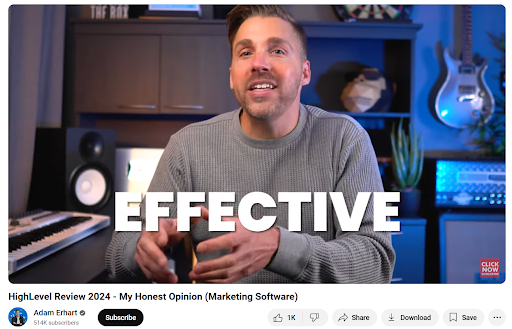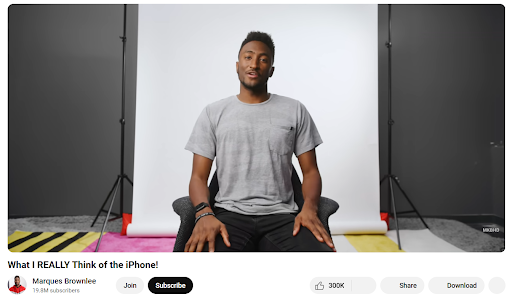Would you trust a mechanic or an actor for car-buying advice? One has expertise, the other has fame — but both are influencers shaping purchase decisions.
From the first century, where religious figures influenced people toward ethical living, to Josiah Wedgwood leveraging royal connections to sell pottery, to Kim Kardashian marketing bodysuits … history has always seen figures using their credibility to sell something. Whether it’s an idea, a product, or a movement, the core principles of influence remain unchanged.
While currency, technology, and advertising methods have evolved, human buying motivators dating back to 6000 BCE have largely stayed the same. And in 2025, the game remains unchanged: driving sales and influencing buyer decisions is still the goal. What has evolved, however, is the type of influencer content that resonates with audiences.
Why influencer content resonates with buyers
Consider this: SaaS giant ServiceNow recently tested two different ads — one featuring British actor Idris Elba and another showcasing LinkedIn content creator and thought leader Ankur Warikoo. Which do you think performed better? The actor or the subject matter expert?
While both were advertisements, Warikoo had demonstrated expertise in the field and had previously advocated for the product. He was paid to create content, not just to endorse a brand with a scripted line. This is why influencer content consistently outperforms traditional branded content — audiences trust subject matter experts more than celebrity endorsements.
In fact, consumers are more likely to make a purchasing decision after seeing an influencer ad versus a traditional brand advertisement. According to G2, 60% of marketers believe influencer-generated posts perform better than branded content.
Social media posts (56% of those surveyed) are currently the most effective content type for B2B marketing influencer programs, according to the 2025 B2B Influencer Research Report.
“I like to think about how I can bring influencers into every aspect of our marketing efforts. In my experience, social media posts, live streams, webinar hosting, and newsletters are the most effective content types.” – Nic Michael, Senior Manager of Social Media & Influencer Marketing, DataRobot
Psychological triggers in influencer content
At our core, human psychology influences every purchase decision we make. Three main triggers drive buying behavior:
1. Social proof
If you followed the NFL in the late 2010s, you might recall nearly every athlete sporting Beats by Dre headphones, fueling massive demand. That’s social proof — a psychological phenomenon that ensures people follow the crowd. When influential figures use a product, it inherently builds credibility.
69% of respondents are likely to trust a friend, family member or influencer recommendation over information coming directly from a brand (Matter)
2. Scarcity
How many influencer ads have you seen promoting early-bird tickets before major conferences like Dreamforce or Adobe Summit? Limited-time offers create a sense of urgency, prompting audiences to act quickly.
Approximately 60% of consumers have made purchases driven by FOMO, with many acting within 24 hours of encountering a product or offer. (ConvertMate)
3. Reciprocity
Brands and influencers often offer something valuable — like a free trial, exclusive content, or a discount — in exchange for engagement. This triggers an innate sense of obligation, making consumers more likely to reciprocate with a purchase.
Approximately 49.9% of consumers convert to paid subscriptions after an opt-out free trial (First Page Sage)
Get the Full Story on B2B Influence
Influencer content types that shape purchase decisions
B2B and B2C purchasing behaviors aren’t as different as they might seem. At the end of the day, business buyers are still consumers, driven by trust and authenticity. Let’s explore the most effective types of influencer content today, according to a recent survey from Bazaarvoice.
1. Honest reviews of pros and cons
When’s the last time you bought something (outside of groceries) without checking reviews? Consumers — and businesses — value balanced, transparent feedback. The report from Bazaarvoice found that honest reviews of both pros and cons were the top influencer content factor affecting U.S. shopper decisions.
- Example: Marketing expert Adam Erhart shares an honest review of HighLevel software via this high-quality video.

2. Detailed Product Information and Specifications
Have you ever watched an influencer say, “This is amazing,” or “Gamechanger!” without explaining why? While surface-level praise works to some extent, the study found that 44% of consumers prioritize detailed product specifications when making purchasing decisions.
For B2B buyers, who are making substantial investments, influencers must provide comprehensive product details to ensure informed decision-making.
- Example: Marques Brownlee, while known for consumer videos, is perhaps the perfect example of an influencer/creator generating content that provides all the detailed product information one could ask for, from a relatable perspective.

3. Product demonstrations
Would you buy a guitar without hearing how it sounds? A camera without seeing its capabilities? Unsurprisingly, buyers want to see products in action before committing. The Bazaarvoice survey ranked product demos as the third most influential type of content.
For B2B, where products like CRM platforms or AI-powered tools aren’t visually exciting, here’s how to create engaging demos:
Short-form clips: Quick, digestible 30-60 second videos showcasing top features.
Hands-on walkthroughs: Long-form content breaking down key functionalities.
User experience proof: Real-world application of the product in a business setting.
Comparison and use cases: Showcasing different solutions or industry-specific applications.
Live Q&A/Webinars: Interactive sessions allowing potential buyers to engage directly.
- Example: Tech creator Stewart Gauld uses his platform to share in-depth product demonstrations on a variety of business and consumer solutions.
Turning influence into action
The psychology behind consumer purchases applies just as much to B2B as it does to retail. Whether it’s a new TV or enterprise software, buyers seek authenticity and expertise. In 2025, the brands that thrive will be those that partner with influencers who:
- Are genuine fans of their product.
- Provide honest, transparent reviews.
- Share in-depth product knowledge.
- Demonstrate how the product works in real-world scenarios.
By leveraging credible influencers, brands can significantly boost conversions, strengthen trust, and build lasting loyalty. The game hasn’t changed — only the players have.
Need Help Finding the Right Influencers?



